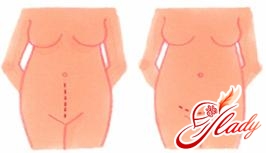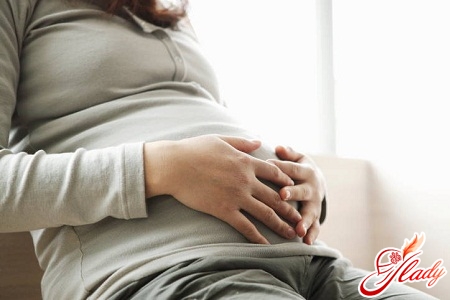 Cesarean section - surgical operationUsed to extract a child through a cut in the abdominal wall and uterus, if labor through natural ways is considered too difficult or dangerous for the mother and / or child. For the first time about Cesarean section is mentioned in Pliny the Elder; there is evidence that the cesarean section was known in ancient Egypt and in ancient India, but it was rarely done, since the possibilities of medicine were very limited, and the risk with such a surgical intervention is great. In ancient times this operation was done mainly in the case of the death of the mother - in order to save the fetus. In Russia Caesarean section was first produced in the middle of the XVIII century. In cesarean section (under general anesthesia or under epidural anesthesia), the abdominal wall is cut, then a longitudinal incision is made of the uterine wall, after which the fetus and the pelvis are removed from the uterine cavity. Your doctor may warn you that you may need a caesarean section. First of all, try to calm down and comprehensively discuss this problem with your doctor, collect and study as much information as possible on this issue. Today, cesarean delivery is almost as safe for the mother as the birth in a natural way, and when a fetus is threatened, it is often even safer for the fetus. Although Caesarean section is considered a serious operation, but the risk associated with it is compared with the risk of removing tonsils or gall bladder. Every year, thousands of children who could die or be maimed in the course of natural childbirth are born healthy in a cesarean section. Compared with other surgical operations, it is very safe. Births are more convenient, quick and predictable than through natural ways. The operation itself is usually painless, since it is performed under anesthesia. The doctor also receives a higher payment for cesarean delivery. All this makes the cesarean section attractive for both parturient women and doctors. A closer examination, however, reveals major shortcomings, which should limit the use of caesarean section in cases where labor through natural routes is unsafe or impossible. Cesarean section increases the risk of serious problems with anesthesia, infection and bleeding. Longer hospitalization is required. You will have pain weeks after the birth and difficulties in caring for the newborn and other children. You will need more pain medication, antibiotics and blood transfusions are more likely than after natural births. Not so soon you can return to your household duties or to work. Moreover, the financial costs are much greater than with natural childbirth. According to some experts, babies born by Caesarean section have more problems with breathing and maintaining the temperature, especially if there were no fights at all. Even in comparison with prolonged or difficult births through natural ways, this additional risk exists. Such errors and undesirable phenomena should be warned from the very beginning. First, it should be understood that the way in which a child was born does not in any way affect either the mother or the child; neither the woman becomes less of a mother, nor is the child less of a product of her womb if it was born with the help of a cesarean section. Secondly, it is important that the mother and the child spend as much time together as possible, beginning with the birth. At the same time, do not panic if you feel too weak to take care of your child, or if your child requires intensive supervision of newborns. There is no reason to believe that the relationship between mother and child is tied only after birth.
Cesarean section - surgical operationUsed to extract a child through a cut in the abdominal wall and uterus, if labor through natural ways is considered too difficult or dangerous for the mother and / or child. For the first time about Cesarean section is mentioned in Pliny the Elder; there is evidence that the cesarean section was known in ancient Egypt and in ancient India, but it was rarely done, since the possibilities of medicine were very limited, and the risk with such a surgical intervention is great. In ancient times this operation was done mainly in the case of the death of the mother - in order to save the fetus. In Russia Caesarean section was first produced in the middle of the XVIII century. In cesarean section (under general anesthesia or under epidural anesthesia), the abdominal wall is cut, then a longitudinal incision is made of the uterine wall, after which the fetus and the pelvis are removed from the uterine cavity. Your doctor may warn you that you may need a caesarean section. First of all, try to calm down and comprehensively discuss this problem with your doctor, collect and study as much information as possible on this issue. Today, cesarean delivery is almost as safe for the mother as the birth in a natural way, and when a fetus is threatened, it is often even safer for the fetus. Although Caesarean section is considered a serious operation, but the risk associated with it is compared with the risk of removing tonsils or gall bladder. Every year, thousands of children who could die or be maimed in the course of natural childbirth are born healthy in a cesarean section. Compared with other surgical operations, it is very safe. Births are more convenient, quick and predictable than through natural ways. The operation itself is usually painless, since it is performed under anesthesia. The doctor also receives a higher payment for cesarean delivery. All this makes the cesarean section attractive for both parturient women and doctors. A closer examination, however, reveals major shortcomings, which should limit the use of caesarean section in cases where labor through natural routes is unsafe or impossible. Cesarean section increases the risk of serious problems with anesthesia, infection and bleeding. Longer hospitalization is required. You will have pain weeks after the birth and difficulties in caring for the newborn and other children. You will need more pain medication, antibiotics and blood transfusions are more likely than after natural births. Not so soon you can return to your household duties or to work. Moreover, the financial costs are much greater than with natural childbirth. According to some experts, babies born by Caesarean section have more problems with breathing and maintaining the temperature, especially if there were no fights at all. Even in comparison with prolonged or difficult births through natural ways, this additional risk exists. Such errors and undesirable phenomena should be warned from the very beginning. First, it should be understood that the way in which a child was born does not in any way affect either the mother or the child; neither the woman becomes less of a mother, nor is the child less of a product of her womb if it was born with the help of a cesarean section. Secondly, it is important that the mother and the child spend as much time together as possible, beginning with the birth. At the same time, do not panic if you feel too weak to take care of your child, or if your child requires intensive supervision of newborns. There is no reason to believe that the relationship between mother and child is tied only after birth.  In some cases, for certain indications, the decision on cesarean section can be made in advance:
In some cases, for certain indications, the decision on cesarean section can be made in advance:
- Disproportionate pelvis and head(utero-fruit); (the fetal head is too large to pass through the mother's pelvis); This is indicated by the size of the child, determined by ultrasonographic research, or difficult previous births;
- Disease or other abnormalities of the fetus that cause risk or injury during self-delivery;
- End of previous pregnancy with caesareanas the cause of caesarean section continues to pose a threat (eg, a mother's disease or an abnormal pelvic structure) or if the uterus has been vertically dissected;
- High blood pressure or kidney disease of the mother: the mother may not be able to bear the birth stress;
- Incorrect position of the fetus, such as pelvic presentation (buttocks or feet forward) or transverse presentation, which can make independent birth difficult or even impossible.
There are also causes that determine the cesarean section long before delivery:
- Diabetes maternal diabetes in the case when the termination of pregnancy is necessary before the term and the insufficient maturity of the cervix is confirmed;
- Infection of the viral type, available at the time of onset of labor; cesarean section is also done to prevent infection of the fetus during its passage through the birth canal;
- Placenta previa (when the child's place partially or completely blocks the opening of the cervix), which can cause bleeding if the baby's place begins to separate early;
- Early separation of the child's place - clearly separating the child's place from the uterus wall, creating a great danger to the fetus.
Caesarean section is also shown in the case whenan urgent termination of labor is necessary, there is no time to activate labor or if it is allowed that the mother and / or the fetus will not be able to bear the stress caused by childbirth. There may be other reasons:
- The state of pre-exclamptic disease or exlampsia, which does not respond to treatment;
- A delayed pregnancy (exceeding the term of labor for 2 or more weeks) leads to a worsening of the fetal conditions in the uterus;
- The emergence of a threat to the life of the fetus or the mother.
However, often the decision on the need for caesarean section is already taken in the process of delivery. The reason for this can serve as the following phenomena:
- Lack of labor (cervixopens too slowly) after 16-18 hours from the beginning (some doctors wait even longer). Occasionally, oxytocin is also used to stimulate the spastic activity of the uterus before deciding on cesarean delivery;
- Fetal hazard phenomena noted during observation with special instruments or other tests;
- Abaissement of the umbilical cord: its compression can cut off the flow of oxygen to the fetus, causing a threat to his life;
- Unrecognized previous cases of placenta previa or premature separation of a child's place - especially if there is a risk of bleeding.
Incisions of skin and uterus
During the operation, the doctor makes two incisions: the first incision - the abdominal wall (skin, fat and connective tissue), the second - the uterus. The abdominal muscles are not cut; they move apart, which allows them to heal more easily. Both cuts can be vertical or horizontal (transverse) or one can be vertical, the other horizontal. For example, the cut of the skin can be horizontal, and the uterus - vertical. It is important for future births to know what kind of incision you have had. This must be indicated in the medical history. There are two types of skin incisions for caesarean section: 
There are three types of uterine incisions: 
When deciding on a cesarean section,you and your doctor must weigh the risks and benefits. Caesarean section risk only pays off in situations where labor through natural ways can create an even greater risk for the mother or child. Undoubtedly, you should trust your doctor, believing that the decision about cesarean section will not be taken without special need. We must first discuss a number of issues.
- Are other methods of delivery possible beforea decision was made about caesarean section (excluding unexpected situations)? For example, the use of oxytocin to stimulate spasmodic activity or the use of standing position to increase activity attempts? True, it should be noted that in domestic clinics, alternative methods of delivery are rarely used.
- Is it possible before attempting to decide on operative labor (due to pelvic fetal presentation) to try to turn the head outwardly (to change the position of the fetus)?
- What kind of anesthesia can be used? When is general anesthesia applied? You can also use extradural anesthesia (to remain conscious) when the cesarean section is not done unexpectedly?
- During the passage of labor, the doctorthe uterus is low, in the lower part, so that there is a possibility of ending the next pregnancy in a natural way? You should also stipulate (because of cosmetic considerations) what a cut of the abdominal tissue will look like (which is usually not associated with the incision of the uterus).
- During the section (with or without consciousness), can your spouse or close relative be present?
- Can you or your partner keep the baby directly after birth and
- can you feed your child in the operating room? Will your partner be able to keep the baby if the operation is under general anesthesia? Can you be with the child in one room, if the child does not require special care? Will your relatives be able to stay at night to help you?
After cesarean section
Within a few days the incisions will hurtstrong enough, and you will need anesthetic. It is necessary to decide for yourself: how much of an anesthetic for you is acceptable. You can take it as little as possible, but if the pain prevents you from caring for the baby, it is wiser to take sufficient doses to feel comfortable. You can discuss the decision with the doctor, and it is better to heed his advice. The first days after cesarean section are especially difficult: to roll over on one side, to breathe, to cough - everything is given with difficulty. Here are some simple tips that will make you feel more comfortable:
- Turn from back to back
Bend your knees so that your feet rest onthe plane on which you are lying. Stand with your feet and lift your hips so that your body straightens from your shoulders to your knees. Turn the hips to the side and lower them. Then turn the upper body in the same direction. You lie on your side. This way of rotation saves your seams from damage and relieves elbows from painful rubbing about the sheets.
- Cough
Cough is given pain, but after a general anesthesiaCoughing is necessary to get rid of the mucus that accumulates in the lungs and sometimes causes an infection. Use the following method: strengthen your stitches with your hands, with a small pillow or tie with a towel. Take a deep breath, completely filling the lungs. Exhale completely - strongly and sharply, but gently - drawing in your stomach, and not inflating it. Publish the sound of "wow". Repeat several times within an hour, especially if you feel gurgling or sobs in your chest. If the chest is clean and you regularly get out of bed, you do not need to do this often. It is useful to try these techniques before surgery to understand how it is done.
- Rise to the feet and walk
You will first risk getting up from bed througha few hours after the operation. A nurse or your loved ones will help you sit down, then get up. When you first rise, you may feel weak and dizzy. You can reduce dizziness by making exercises in your arms and legs to improve blood circulation. Take your time, let yourself get used to each new state, when you move from a lying position to a standing position. Here's how to get out of bed: turning on your side, let your legs hang from the edge of the bed and put yourself in a sitting position. Sit a little and do the movements with your feet. When you are ready, put your feet on the floor and stand up (with someone's help). Stay as straight as possible. It will not hurt your seams, even if it seems that they stretch. Once you get used to standing, take a small step. Every time you get out of bed, you will notice that it's becoming easier and easier. Try to gradually increase the duration of your walks.
- Intestinal gases
Intestinal gases sometimes become reala problem after cesarean section, as well as after any operation on the abdominal cavity. You will be puked, there may be acute pain until you release the gases. The accumulation of gases is caused by the slowing down of intestinal activity as a result of the operation. Moving forward and back in bed, deep breathing, swinging in the chair will help prevent or facilitate the accumulation of gases. Try also to avoid foods and beverages that emit gases. A nurse can put you a gas pipe or enema to help get rid of the gases if you can not yourself.
- Urination
There may be difficulties with urinationafter a catheter in the ureter, anesthesia and abdominal surgery. The nurse will offer you ways to help cope with this problem. If you can not urinate for a reasonable period of time, you may need to re-insert the catheter.
- Lactation
It is possible and desirable to breast-feed aftercesarean section, but finding a comfortable position can be a problem. To protect your seams from the weight and body movements of the baby, put it next to you on the pillow or place the pillow over the seams before you take the baby in your arms for feeding. Perhaps it will be more difficult for you to restore your strength compared to women who have given birth naturally. But give yourself time, the pain will soon pass. At first you have to help someone in the care of the child and in domestic chores. But as soon as your physical condition allows you to begin postpartum exercises. Consult the doctor beforehand.
Natural delivery after cesarean section
Most women who underwent a cesarean section,can and should, for safety reasons, give birth naturally in the next pregnancies. The current cesarean surgical procedures almost always leave the uterus strong and healthy, with a well overgrown suture. In fact, now that physicians and midwives have gained extensive experience in conducting labor through natural paths after a previous cesarean section, they hardly see it as an additional risk for most women. Their experience is consistent with numerous reports in the medical literature confirming the safety and benefits of natural births after cesarean section before repetition of the operation. Among the benefits are a smaller maternal and infant mortality, a lack of postoperative complications, a shorter stay in the hospital, economic benefits, the ability to return to normal life rather than psychological advantages. There are some situations where labor through natural paths after cesarean section is impossible or unreasonable, for example, when the indications for surgery are preserved. If you suffer from a chronic illness or your physical condition makes natural births unsafe or impossible, you should probably agree to a cesarean section again. In most cases, however, the reasons for the first caesarean section do not appear again. The most frequent indications for the first caesarean section - lack of progress, malaise, poor presentation or fetal affection - are rarely repeated during the next pregnancy. In the case of a high vertical (classical) incision, the risk that the suture will disperse during labor is slightly higher than in the case of a low transverse incision. Most doctors speak in support of natural births after caesarean section only in the case of a low transverse suture, although if a woman with a classic incision is informed of the risk, but strives for natural childbirth, some doctors will support her aspirations. Many professionals believe (comparing the risk of a uterine rupture or a repetition of a cesarean section) that delivering through natural ways after cesarean section is a safer option. We advise you to read:









